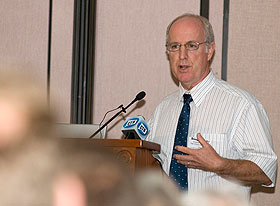  |
| HOME | THIS ISSUE | CALENDAR | GRANTS | BACK ISSUES | < BACK | NEXT > |
Planting native species promotes biodiversity, says speakerby Elizabeth Omara-Otunnu - October 14, 2008
| ||||
Incorporating native plants into landscape design can play an important role in promoting biodiversity, according to ecologist Doug Tallamy. “We need to change our landscaping paradigms,” said Tallamy, a professor of entomology and wildlife ecology at the University of Delaware. “Animal diversity needs native plants.” Tallamy was the keynote speaker at a day-long symposium on invasive plants held at Rome Ballroom Oct. 1. The event was organized by the Connecticut Invasive Plant Working Group, a coalition of concerned individuals, organizations, and agencies. The group is co-chaired by UConn’s Donna Ellis of the Department of Plant Science and Les Mehrhoff of the Department of Ecology and Evolutionary Biology. Tallamy said that despite extensive degradation of the environment by humans, individuals can have a positive impact on biodiversity in their own backyards by planting native species. Biodiversity is needed for a healthy ecosystem, he said, and animal diversity comes from plants. Tallamy said the destruction of nature by human beings “has happened so many times in so many places, we’re losing the species we share the planet with. … We don’t make the mental connection between how important other living things are and our own well being.” Plants – because they produce food for other species and their structures offer a place for other species to live – determine the number of species that can live in a space indefinitely without degrading resources. This is known as carrying capacity. Not all ecosystems have the same carrying capacity, he said. A deciduous forest, for example, has a higher carrying capacity than a lawn. The carrying capacity of the United States has been depleted, he said. Suburbs and cities make up 54 percent of the country, and these support very little biodiversity. “The carrying capacity of suburbia is extraordinarily low,” said Tallamy, “because it was not designed for biodiversity, it was designed for convenience.” Not all plants support wildlife equally, he said. Plants that evolved elsewhere don’t support wildlife as well as native plants. “In a typical suburban landscape, none of the plants are native,” he said. Tallamy described an experiment he carried out in his own backyard, comparing the biomass of caterpillars on native plants and on alien species. He found 35 percent more on native than on alien species. “That’s 35 times more bird food,” he said. On average, an alien plant supported only four species, compared with 71 species on a native plant.
Tallamy said 90 percent of insect herbivores are specialists on one or a few plants, having evolved a resistance to the plant’s defensive mechanisms. “That’s only a problem if you take away the host plants,” he said. When faced with non-native plants, on the other hand, insects may not even recognize them as potential food. In the absence of insect pests, many alien plants thrive, some to the point of becoming invasive. It is not only insects that are affected. Other insects, spiders, amphibians, rodents, and birds – even some mammals, such as bears – all eat insects. If the insects are not there, said Tallamy, the organisms that depend on them will not be there either. But all native plants are not created equal in their ability to support biodiversity either. Oaks are at the top of the list: they support 534 species of moths and butterflies in the mid-Atlantic states, said Tallamy. By comparison, a tulip tree, another native species, supports 21 species. “The plants you choose for your landscape are important,” he said. “Make it native, and make it one of the more productive species.” A list of native species suitable for planting is available on Tallamy’s web site: http://copland.udel.edu/~dtallamy/host/index.html He said the local environment responds quickly. In a recent study comparing six properties near Pennsylvania that had been specially landscaped for native species with conventionally landscaped but otherwise similar properties, he found a significant difference in both the absolute number and the number of different species of caterpillars and birds on the native plants. The properties with native plants had all been landscaped within the previous three years. Noting that many gardeners buy non-native plants precisely because they’re sold as pest-free, he said property owners should not worry that planting native species will result in an infestation of insects. Instead, the availability of more insects will attract more species that feed on those insects. Planting natives is a grassroots approach to conservation, he said, adding, “The way we garden today is going to determine what life looks like tomorrow.” |
| ADVANCE HOME UCONN HOME |

